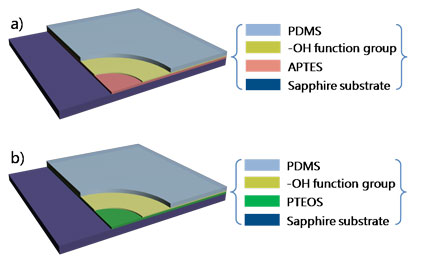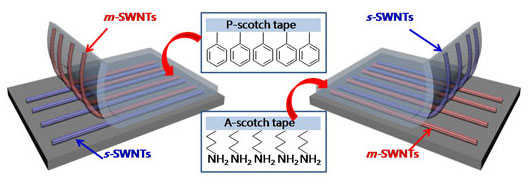| Posted: Jun 14, 2011 | |
Separating metallic and semiconducting single-walled carbon nanotubes by 'scotch tape' |
|
| (Nanowerk Spotlight) Current production methods for carbon nanotubes (CNTs) result in units with different diameter, length, chirality and electronic properties, all packed together in bundles, and often blended with some amount of amorphous carbon. Often, these mixtures are of little practical use since many advanced applications, especially for nanoelectronics, are sensitively dependent on the structures. Consequently, the separation of metallic (m) and semiconducting (s) CNTs is essential for future applications and studies. | |
| Separation of nanotubes according to desired properties is still proving to be a challenging task, especially single-walled carbon nanotube (SWCNT) sorting. The composition of SWCNTs of different types is very similar, but the chemical properties are not. Conventional separation techniques are efficient in separation of carbon nanotubes, but there are many drawbacks. | |
| Researchers in Asia have now developed a simple way to realize the separation of single-walled carbon nanotubes via the interaction difference between chemicals and carbon nanotubes. | |
| "Considering the problems associated with separation techniques such as selective destruction and solution-based methods, our goal was to develop a simple way, which is analogous to mechanical exfoliation of graphene using scotch tape to realize SWCNT separation," Jin Zhang, a professor of chemistry and molecular engineering at Peking University, explains to Nanowerk. "Specifically, we aimed to create 'scotch tapes' terminated with various functional groups that could be used to selectively remove either s- or m-SWCNTs and to leave their counterparts on the substrate." | |
| As Zhang points out, unlike other separation techniques, this approach is based on the selective adsorption of chemicals to SWCNTs of different electrical properties, which can be applied to long SWCNTs systems without introducing damage while the SWCNTs formation is perfectly maintained. | |
| Reporting their method in the June 6, 2011 Early View issue of Angewandte Chemie International Edition ("Separation of Metallic and Semiconducting Single-Walled Carbon Nanotube Arrays by 'Scotch Tape'"), the researchers used chemically modified PDMS thin-films as 'scotch tape'. | |
 |
|
| Schematics of A- and P-scotch tape. (Reprinted with permission from Wiley-VCH Verlag) | |
| For their experiments, the researchers used PDMS thin-films as supporting material while aminopropyltriethoxysilane (APTES – the 'A-scotch tape') and triethoxyphenylsilane (PTEOS – the 'P-scotch tape') were used as bonding material to introduce amine and phenyl functional groups, respectively. After treated under air plasma, The Si-O-Si bonds on PDMS surface were oxidized to Si-OH groups, which could further react with APTES/PTEOS to form a strong interaction between the supporting PDMS layer and functionalized bonding layer (see figure above). | |
| "When we applied the PDMS-based scotch tapes to SWNT samples and then peeled off, the A-scotch tape selectively removed s-SWCNTs, while the P-scotch tape adhered to metallic ones, leaving their counterparts on the substrate," says Zhang. | |
 |
|
| Schematic of SWNT separation using P- and A-scotch tapes to selectively remove m- and s-SWCNTs respectively, and leave their counterparts on the sapphire substrates. (Reprinted with permission from Wiley-VCH Verlag) | |
| Importantly, there is no need for the SWCNTs to be dissolved into solution before being separated by chemicals, therefore avoiding potential contamination through the solution. | |
| "Unlike with the selective destruction methods, there was no damage introduced to the SWCNTs during the separation process" says Zhang. "Moreover, SWNT alignment can be perfectly maintained and there is no limitation to SWNT length, since the technique is not solution based. This method is also useful for SWNT separation over large areas, as the PDMS films are simple to synthesize." | |
| Going forward, the research team will now try to optimize the fabrication technique of their 'scotch tape' with the goal of making it compatible for industrial use. They will also try to work with other materials to make it even cheaper. | |
| According to Zhang, they are also interested in designing a special structure of their tape in order to be able to separate single-chirality SWCNTs | |
 By
Michael
Berger
– Michael is author of three books by the Royal Society of Chemistry:
Nano-Society: Pushing the Boundaries of Technology,
Nanotechnology: The Future is Tiny, and
Nanoengineering: The Skills and Tools Making Technology Invisible
Copyright ©
Nanowerk LLC
By
Michael
Berger
– Michael is author of three books by the Royal Society of Chemistry:
Nano-Society: Pushing the Boundaries of Technology,
Nanotechnology: The Future is Tiny, and
Nanoengineering: The Skills and Tools Making Technology Invisible
Copyright ©
Nanowerk LLC
|
|
|
Become a Spotlight guest author! Join our large and growing group of guest contributors. Have you just published a scientific paper or have other exciting developments to share with the nanotechnology community? Here is how to publish on nanowerk.com. |
|
